Water and Soil Flume
The Water and Soil Flume of Deltares is often used by our partners from the maritime, energy, dredging, and mining industry. This experimental facility is the go-to facility for soft soil-related R&D and innovations. It consists of a 50m long and 2.5m deep flume with carriage system to tow an object or dredge installation through water or soil at a prescribed speed.

Unique features of the Water and Soil Flume
The Water and Soil Flume is a big flume (50 m length, 5.5 m width, 2.5 m depth). It has the flexibility of constructing smaller compartments with glass panels in the main flume, allowing studies at different scales ranging from around 1m3 to 500 m3 test setup. It has a carriage and rail system on top of the in-ground concrete flume, which offers the possibility of towing an object in the flume with a controlled speed ranging from 1 mm/s up to 2.5 m/sec. This carriage can also be used to pull or push an object horizontally through the soil-water mixture in the flume.
The Water and Soil Flume offers the unique possibility that the pumps and installations can deal with sand and mud (cohesive sediment) in the flume. Additionally there is a plexiglas smaller flume (25m length, 0.5m width, 0.7m depth) for cheaper testing on smaller scale. This smaller flume can also deal with water, sand and mud.
The following additional facilities are available to enable different types of experiments:
- A clay factory with a production capacity of about 12 tons/day of clay with a desired strength/properties of up to 70 kPa undrained shear strength.
- A sand conditioning machine which is used to achieve a different level of compaction in a sand deposit using a beam with 5 vertical vibrating compaction needles.
- A hexapod platform used for multiaxial shearing and fluidisation tests (with a max. carrying capacity of 500 kg weight of soil sample), allowing the movement in 6 degrees of freedom.
The Water and Soil Flume is equipped with plenty of measurement devices to monitor and characterise properties of the soft soil-water mixture, for instance:
- Sand concentration conductivity system.
- (pore) Pressure sensors.
- Flow meters.
- Seepage-induced consolidation (SIC) to examine the permeability and compressibility of soft soil samples under larger stresses.
- Shear cell system to characterise sand segregation under the influence of shear flow.
- Several low and high tech rheometers to characterise the flow behavior of non-Newtonian soft soils.
- Different fiber optics-based monitoring systems (e.g. DTS, DAS) for real-time monitoring of various subsurface properties.
- Laser-based Particle Image Velocimetry to visualise the flow field velocity.
- Malvern to characterise the grain size distribution of soft soil samples.
- Fall cone to measure the undrained strength of soft soil samples.
- And many more.
You have not yet indicated whether you want to accept or reject cookies. This means that this element cannot be displayed.
Or go directly to:
Applications
The Water and Soil Flume can be used for large scale tests of complex interactions between water, sediment and the sea- or riverbed. Recently for example experiments have been conducted for optimising installation techniques of monopiles or for heat and cold storage in the subsurface. Both developments are useful for the energy transition of the Netherlands and the world.
Experiments on improving dredging techniques have been performed in the Water and Soil Flume. For instance jetting in sand, clay or mud (Water Injection Dredging) and sailing through mud tests have been done in the Water and Soil Flume. With the knowledge from these experiments the emissions, environmental impact and costs of maintenance dredging in ports and waterways can be optimised further.
We investigate and develop new measurement techniques like fibre optics to measure in-situ soil characterisation, heat transfer and deposition layer thickness in the Water and Soil Flume. Dredging cutter heads, suction devices, dragheads and deepsea mining collectors are tested in the Water and Soil Flume. We investigate the physics of non-Newtonian flow, plume dispersion of turbidity plumes, bubble screens, breaching of densely packed sand, sand/mud mixture flow in the Water and Soil Flume.
Also geotechnical processes for geotechnical stability of infrastructures under frequent inundation, and mud or sand placement under water or above water is tested including beach formation of tailings and slurries. In addition to the Water and Soil Flume we have a physical-chemical lab for characterisation of mud properties, grain size distribution or other information of sediment samples.


